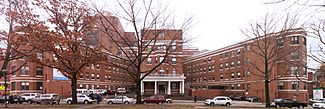Western Pennsylvania Hospital facts for kids
Quick facts for kids West Penn Hospital |
|
|---|---|
| Allegheny Health Network | |
 |
|
| Geography | |
| Location | 4800 Friendship Avenue, Pittsburgh, Pennsylvania, United States |
| Coordinates | 40°27′41″N 79°56′47″W / 40.46139°N 79.94639°W |
| Organization | |
| Funding | Non-profit hospital |
| Affiliated university | Temple University |
| Services | |
| Beds | 317 |
| History | |
| Founded | 1848 |
The Western Pennsylvania Hospital, usually called West Penn Hospital, is a big hospital in Pittsburgh, Pennsylvania. It is located at 4800 Friendship Avenue in the Bloomfield area. This hospital has 317 beds and is part of the Allegheny Health Network. It helps train new doctors and nurses. Many doctors learn here through special programs. The hospital also has its own nursing school.
Contents
How West Penn Hospital Started
West Penn Hospital was founded a long time ago, on March 18, 1848. It was the very first public hospital in Pittsburgh. Its first location was on a hillside. This spot overlooked the city's Strip District. Today, that land is a ball field and a park.
Opening the First Hospital
It took five years to design and build the first hospital. There were some problems with money and construction. Finally, the four-story hospital opened in the spring of 1853. It could hold 120 patients. Many early patients were people hurt in accidents. These accidents often happened in Pittsburgh's busy mills and rail yards.
Helping with Mental Health
In 1862, West Penn Hospital opened another special place. It was called the Dixmont Hospital. This hospital helped people with mental health issues. It was the first facility of its kind in Western Pennsylvania. Dixmont Hospital was named after Dorothea Dix. She worked hard to get money for the hospital. West Penn owned Dixmont until 1907.
West Penn During the Civil War
The American Civil War happened from 1861 to 1865. During this time, West Penn Hospital became a main place for treating soldiers. The United States government took over the hospital in 1862. They changed it to be a military hospital for three years. Civilians could still get emergency care there. By the end of the war in 1865, about 3,000 soldiers had been treated at West Penn.
Training Doctors and Nurses
West Penn Hospital has a long history of teaching medical professionals.
The First Medical School
The Western Pennsylvania Medical College started in October 1886. It was founded by doctors from West Penn Hospital. This was the first medical school in the region. The school building was next to the hospital. It was connected by an underground tunnel. The medical school later became The University of Pittsburgh School of Medicine.
Starting a Nursing School
The nursing school opened in 1892. It was called The Western Pennsylvania Hospital Training School for Nurses. There were fifteen students in the first class. Ten students finished the two-year program. They graduated on September 20, 1894.
Growing Bigger
As Pittsburgh grew, so did West Penn Hospital.
Moving to a New Location
By the early 1900s, the first hospital building was old. The hospital decided to build a new one. This new hospital was in the Bloomfield neighborhood. The first stone for the new building was laid in 1909. On New Year's Day, 1912, the new West Penn Hospital opened. All 219 patients were moved to the new building. This six-story hospital could hold up to 500 patients. It had modern operating rooms and X-ray machines.
Expanding the Nursing School
In 1919, the hospital bought more land. By 1923, they opened a "Residence and Training School." This is now the West Penn Hospital School of Nursing. Today, this building is used by nurse educators and students. It also has a special center for teaching using simulations.
Adding New Services
West Penn kept growing and adding new parts. In 1950, they added a new area for babies being born. An intensive care unit (ICU) was added in 1958. In the 1960s, there was another big expansion. A new entrance was built on Millvale Avenue. A new center for outpatient care, called Mellon Pavilion, opened in 1970. The hospital also opened a famous Burn Care Unit in 1970. A heliport for helicopters was added in 1971. The East Tower, for special diagnostic care, opened in 1981. A tall, nine-story patient care tower was added in 1995. It has a copper dome that you can see from far away.
Becoming Part of a Larger Network
West Penn Hospital has joined with other hospitals over the years.
Joining the Allegheny System
In 1999, West Penn Hospital joined with four other hospitals. These hospitals were Allegheny General, Forbes, Allegheny Valley, and Canonsburg. They all became part of the West Penn Allegheny Health System. This helped the hospitals stay open and continue to serve patients.
Partnering with Highmark
Around 2010, the West Penn Allegheny Health System faced money problems. They even had to close West Penn's emergency room for a while. In June 2011, a company called Highmark agreed to help. Highmark invested a lot of money into the system. This helped save West Penn Hospital from closing. The emergency room reopened in February 2012. In 2013, West Penn became part of Highmark's Allegheny Health Network.
Today, West Penn Hospital is a 317-bed teaching hospital. About 4,000 babies are born there each year. It has a special unit for tiny babies who need extra care. The hospital also has a special center for treating burns in both adults and children. Many other services bring patients from all over the state. In 2006, West Penn was the first hospital in its area to win a special award for excellent nursing care. It has received this award three times in a row.
Gallery
See also
- Allegheny General Hospital
- Allegheny Health Network





